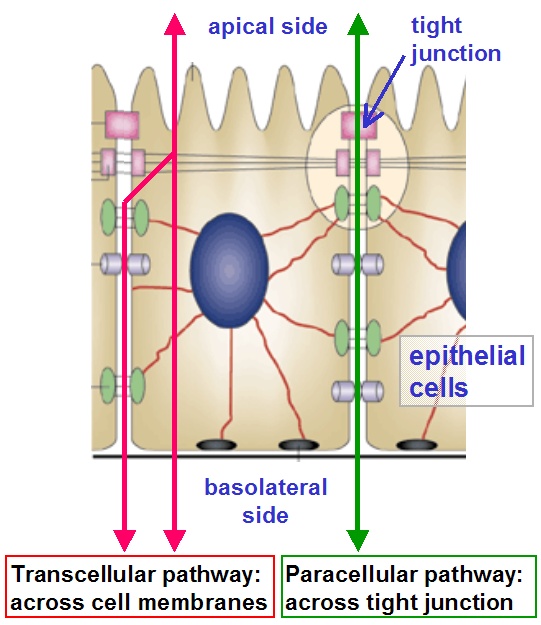| DFG Research Unit FOR 721 Molecular Structure and Function of the Tight Junction |
|
|
Summary |
Tight Junctions (occluding junctions, Zonulae occludentes) consist of proteins which interconnect laterally neighbouring cells of epithelia and endothelia. Some kinds of these proteins seal the tight junction, so that a nearly impermeable barrier develops, others form paracellular channels, which allow for permeation of ions and water between the cells. Accordingly, epithelia of different tightness are formed: "Tight" epithelia like large intestine, distal nephron, epidermis, and brain capillaries or "leaky" epithelia like small intestine, proximal nephron, and peritoneum.


The tight junction proteins occludin, tricellulin, and (in mammals) 24 members of the claudin family are characterized by four transmembrane domains and two extracellular loops. These loops contact like teeth of a zipper with appropriate loops from the neighbouring cell membrane. Tight junctions are regulated in its molecular composition, ultrastructure, and function by intracellular adapter proteins and by the cytoskeleton. This regulation serves physiologic adaptation but also occurs in several epithelial/endothelial diseases.
The groups involved are from the Charité, Campus Benjamin Franklin (4), the FMP Leibniz Institute for Molecular Pharmacology (2), and the Universities Jena (1), Wuerzburg (1) and Hamburg (1).
Main topics are the functions of distinct tight junction proteins as barrier or channel formers for solutes and water, characteristics of the tight junction in inflammatory bowel diseases, posttranslational modifications of tight junction proteins, the relation between renal tight junction proteins and blood pressure control, and the molecular structure of claudin-claudin interactions. New topics of the second funding period (2010 - 2012) are projects dealing with endothelia of blood vessels, peripheral nerves, and the skin. Also new are studies on the permeability for macromolecules and its and its modulation for enhancing drug uptake.
Aim of this research unit is to clarify the relationship between molecular structure and function of tight junction proteins, as well as their regulation and their role in diseases. The results may form a basis for future diagnostical and therapeutical approaches to diseases which seem to have not much in common but are characterized by defects of organ barriers, like Crohn's disease, renal hypertension, inner ear deafness, and cancerous diseases.
|
In the first grant period an international conference was organized. The talks of this conference were published: |
|

|
Another international
conference was organized in
the second grant period. Fromm M, Schulzke JD, Volume Editors (2012) Fromm M, Schulzke JD, Volume Editors (2012)
|